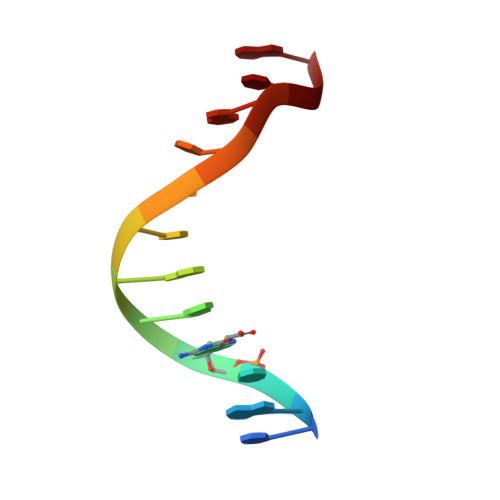O(6)-Carboxymethylguanine in DNA forms a sequence context-dependent wobble base-pair structure with thymine
Zhang, F., Tsunoda, M., Kikuchi, Y., Wilkinson, O., Millington, C.L., Margison, G.P., Williams, D.M., Takenaka, A.(2014) Acta Crystallogr D Biol Crystallogr 70: 1669-1679
- PubMed: 24914978
- DOI: https://doi.org/10.1107/S1399004714006178
- Primary Citation of Related Structures:
4O5W, 4O5X, 4O5Y, 4O5Z - PubMed Abstract:
N-Nitrosation of glycine and its derivatives generates potent alkylating agents that can lead to the formation of O(6)-carboxymethylguanine (O(6)-CMG) in DNA. O(6)-CMG has been identified in DNA derived from human colon tissue and its occurrence has been linked to diets high in red and processed meats, implying an association with the induction of colorectal cancer. By analogy to O(6)-methylguanine, O(6)-CMG is expected to be mutagenic, inducing G-to-A mutations that may be the molecular basis of increased cancer risk. Previously, the crystal structure of the DNA dodecamer d(CGCG[O(6)-CMG]ATTCGCG) has been reported, in which O(6)-CMG forms a Watson-Crick-type pair with thymine similar to the canonical A:T pair. In order to further investigate the versatility of O(6)-CMG in base-pair formation, the structure of the DNA dodecamer d(CGC[O(6)-CMG]AATTTGCG) containing O(6)-CMG at a different position has been determined by X-ray crystallography using four crystal forms obtained under conditions containing different solvent ions (Sr(2+), Ba(2+), Mg(2+), K(+) or Na(+)) with and without Hoechst 33258. The most striking finding is that the pairing modes of O(6)-CMG with T are quite different from those previously reported. In the present dodecamer, the T bases are displaced (wobbled) into the major groove to form a hydrogen bond between the thymine N(3) N-H and the carboxyl group of O(6)-CMG. In addition, a water molecule is bridged through two hydrogen bonds between the thymine O(2) atom and the 2-amino group of O(6)-CMG to stabilize the pairing. These interaction modes commonly occur in the four crystal forms, regardless of the differences in crystallization conditions. The previous and the present results show that O(6)-CMG can form a base pair with T in two alternative modes: the Watson-Crick type and a high-wobble type, the nature of which may depend on the DNA-sequence context.
Organizational Affiliation:
Graduate School of Science and Engineering, Iwaki-Meisei University, Iwaki 970-8551, Japan.
















